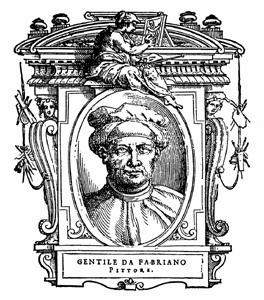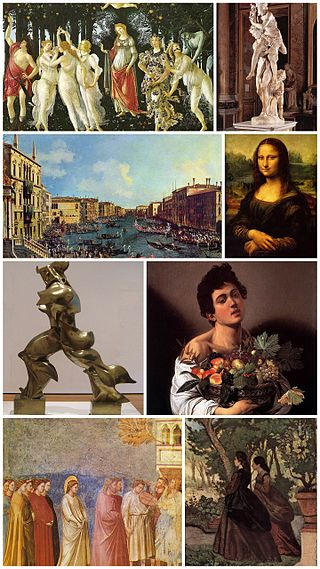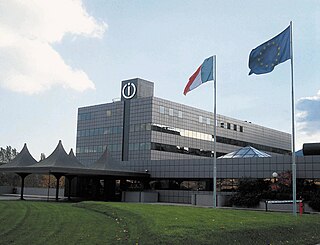| Personal information | |||
|---|---|---|---|
| Date of birth | 17 April 1984 | ||
| Place of birth | Fabriano, Italy | ||
| Height | 1.86 m (6 ft 1 in) | ||
| Position(s) | Goalkeeper | ||
| Team information | |||
Current team | Fabriano | ||
| Number | 1 | ||
| Senior career* | |||
| Years | Team | Apps | (Gls) |
| 2001–2002 | Vis Pesaro | 0 | (0) |
| 2002–2008 | Bellaria Igea Marina | 132 | (0) |
| 2004–2005 | → Vis Pesaro (loan) | 3 | (0) |
| 2008–2009 | Andria BAT | 26 | (0) |
| 2009–2010 | Bologna | 0 | (0) |
| 2010– | Pavia | 4 | (0) |
| *Club domestic league appearances and goals, correct as of 16:06, 19 April 2010 (UTC) | |||
Filippo Spitoni (born 17 April 1984 in Fabriano) is an Italian professional footballer who currently plays as a goalkeeper for Fabriano. [1]

Gentile da Fabriano was an Italian painter known for his participation in the International Gothic painter style. He worked in various places in central Italy, mostly in Tuscany.

Domenico Veneziano was an Italian painter of the early Renaissance, active mostly in Perugia and Tuscany.

Fabriano is a town and comune of Ancona province in the Italian region of the Marche, at 325 metres (1,066 ft) above sea level. It lies in the Esino valley 44 kilometres (27 mi) upstream and southwest of Jesi; and 15 kilometres (9 mi) east-northeast of Fossato di Vico and 36 kilometres (22 mi) east of Gubbio. Its location on the main highway and rail line from Umbria to the Adriatic make it a mid-sized regional center in the Apennines. Fabriano is the headquarters of the giant appliance maker Indesit.

Pisanello, born Antonio di Puccio Pisano or Antonio di Puccio da Cereto, also erroneously called Vittore Pisano by Giorgio Vasari, was one of the most distinguished painters of the early Italian Renaissance and Quattrocento. He was acclaimed by poets such as Guarino da Verona and praised by humanists of his time, who compared him to such illustrious names as Cimabue, Phidias and Praxiteles.

The cultural and artistic events of Italy during the period 1400 to 1499 are collectively referred to as the Quattrocento from the Italian word for the number 400, in turn from millequattrocento, which is Italian for the year 1400. The Quattrocento encompasses the artistic styles of the late Middle Ages, the early Renaissance, and the start of the High Renaissance, generally asserted to begin between 1495 and 1500.

Indesit Company is an Italian company based in Fabriano, Ancona. It is one of the leading European manufacturers and distributors of major domestic appliances. It claims to be the undisputed leader in major markets such as Italy, the UK and Russia. Founded in 1975 and listed on the Borsa Italiana since 1987, the group posted sales of €2.7 billion in 2013. It has eight industrial areas in Italy, Poland, the UK, Russia and Turkey, and 16,000 employees. Since 2022 the majority of the company is owned by the Turkish company Arçelik.

The House of Strozzi is the name of an ancient Florentine family, who like their great rivals the House of Medici, began in banking before moving into politics. Until its exile from Florence in 1434, the Strozzi family was by far the richest in the city, and was rivaled only by the Medici family, who ultimately took control of the government and ruined the Strozzi both financially and politically. This political and financial competition was the origin of the Strozzi-Medici rivalry. Later, while the Medici ruled Florence, the Strozzi family ruled Siena, which Florence attacked, causing great animosity between the two families. Soon afterward, the Strozzi married into the Medici family, essentially giving the Medici superiority.
Engineer Filippo Fiorentini founded the Fiorentini & C. S.p.A. factory of excavators in 1919 in Rome, Italy. He imported and distributed construction equipment. During the time of Fascism, restrictions banned import and Ing. Fiorentini started his manufacturing plant in Via Tiburtina near Stazione Tiburtina for the construction of excavators such as scrapers/draglines and cranes under the license of an American company named Bucyrus.
Fabriano Basket was an Italian professional basketball club based in Fabriano, Marche.

The Coronation of the Virgin or Coronation of Mary is a subject in Christian art, especially popular in Italy in the 13th to 15th centuries, but continuing in popularity until the 18th century and beyond. Christ, sometimes accompanied by God the Father and the Holy Spirit in the form of a dove, places a crown on the head of Mary as Queen of Heaven. In early versions the setting is a Heaven imagined as an earthly court, staffed by saints and angels; in later versions Heaven is more often seen as in the sky, with the figures seated on clouds. The subject is also notable as one where the whole Christian Trinity is often shown together, sometimes in unusual ways. Crowned Virgins are also seen in Eastern Orthodox Christian icons, specifically in the Russian Orthodox church after the 18th century. Mary is sometimes shown, in both Eastern and Western Christian art, being crowned by one or two angels, but this is considered a different subject.

Filippo da Verona was an Italian painter of the early-Renaissance period.

The Diocese of Fabriano-Matelica is a Latin Church diocese of the Catholic Church in the Marche has existed under this name since 1986. It is a suffragan of the archdiocese of Ancona-Osimo.

Antonio da Fabriano was an Italian painter, active in the Region of Marche.
The Master of Staffolo was an anonymous late-Gothic style painter active in the region of Marche and Umbria.
Madonna and Child is another name for Madonna (art). Works with this title include:

The Magnani-Rocca Foundation is a private collection of old masters and modern art, gathered by the art collector and critic Luigi Magnani. He established the foundation in 1978 honour of his father Giuseppe and his mother Eugenia Rocca to promote art, music and literary activities, though it was only from 1983 that he displayed his art collection to the public. It is housed in the Villa Magnani on via Fondazione Magnani Rocca 4 in Mamiano, a district of Traversetolo in the Province of Parma.

Coronation of the Virgin is a tempera painting by the Italian late Gothic artist Gentile da Fabriano, executed c. 1420, now in the Getty Museum. It originated as the front of the a processional banner – the reverse showed Saint Francis Receiving the Stigmata and is now in Parma.
Madonna and Child with Saints is a common theme in Christian art, and is thus the title of a number of works.
Virgin and Child with Two Angels may refer to one of these paintings:
The Coronation of the Virgin is a subject in Christian art.